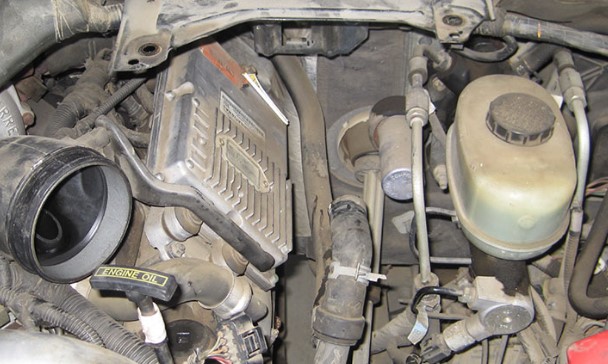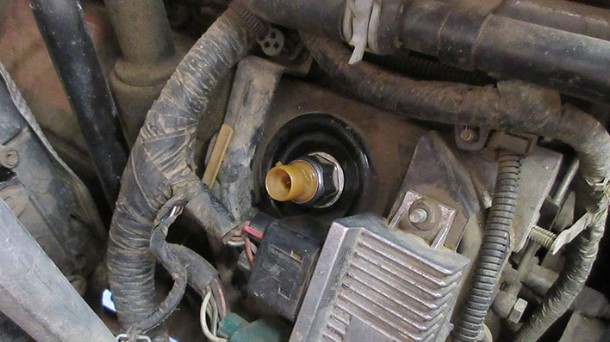The ICP (Injection Control Pressure) sensor on a Ford 6.0 Powerstroke engine relays information to the IPR (Injection Pressure Regulator). If this sensor is not functioning properly, it can lead to hard starts and other performance issues. The symptoms of an failing ICP sensor vary greatly depending on its condition and how much data it is able to relay correctly. Common signs include sputtering, stalling, hard starting, poor acceleration, and rough idling. These problems can worsen over time if the issue isn’t addressed in a timely manner.
If you suspect that your 6.0 Powersrtoke’s ICP Sensor may be faulty or malfunctioning, it is important to get it checked out as soon as possible by a qualified technician or mechanic who specializes in diesel engines. A thorough diagnostic test should be done before any replacement parts are purchased so that the correct part can be identified and replaced quickly and efficiently to restore proper functioning of the vehicle’s engine system.
To avoid further damage or costly repairs due to an improperly functioning ICP Sensor on your 6.0 Powerstroke engine, taking preventative measures such as regularly checking for wear-and-tear signs like frayed wires or loose connections around the sensor itself can help ensure that all components remain working optimally at all times for peak performance from your vehicle’s powertrain system.
What are Icp Sensor 6.0 Powerstroke Symptoms?

1. Engine Warning Light Comes On
The motorist’s bane, the little orange light can be a sign of trouble. When the engine warning light illuminates, it typically indicates that the ECU has detected an issue with one of the engine’s sensors. The ICP sensor is often to blame for this situation, and when this happens, it’s best to take your vehicle into a shop for diagnostics.
Fortunately, there are ways you can check fault codes from your own home; investing in a MOTOPOWER MP69033 Car OBD2 Scanner from Amazon is an effective way to do so. By identifying which codes are associated with the ICP (P2284 – P2291), you’ll have access to more information about what needs replacing or fixing on your car. Additionally, keep in mind that these same codes may indicate other issues if your ICP is working properly such as low oil pressure.
Ultimately, by taking precautionary measures and being proactive when it comes to assessing any potential problems with your vehicle through either professional help or at-home initiatives like purchasing diagnostic scanners online will save time and money in both short-term and long-term scenarios.
ICP Sensor Fault Codes
For those with access to an OBD II (onboard diagnostics) reader, they may experience specific fault codes related to a faulty ICP sensor.
- P2284 – ICP circuit performance fault
- P2285 – ICP signal too low
- P2286 – ICP signal too high
- P2288 – ICP overpressure
- P2289 – ICP overpressure engine off
- P2290 – ICP underpressure
- P2291 – ICP underpressure while cranking
2. Hard Starting
As the fuel management system is heavily reliant on an accurate input from the ICP (Injection Control Pressure) sensor, a failing ICP might be evidenced by difficulty getting the engine going. The 6.0 Powerstroke may not crank easily if the ICP sensor is malfunctioning because incorrect pressure signals are received and interpreted by the fuel management system which in turn results in too much or too little fuel being injected into the engine.
One way to troubleshoot this problem can be done without any equipment—simply unplugging the faulty ICP sensor should cause it to assume default settings and if your engine starts up with no issue then you have found that your hard starting was due to a failed ICP Sensor. This diagnostic process helps pinpoint problems quickly and accurately, allowing for faster repairs and improved driving experiences overall.
Ultimately, understanding how components work together within a vehicle’s complex systems will help drivers identify potential issues before they become major problems down-the-line. Knowing what to look out for when diagnosing issues such as hard starting engines can save drivers time and money as well as keep them safe on their journeys ahead.
3. Sputtering
Problems with the 6.0 Powerstroke engine can be caused by a faulty ICP sensor, which provides information to the ECU about fuel pressure and air flow. If it is misreading this data, the result may be sputtering and misfire when accelerating. Poor-quality fuel or blocked filters could also lead to these problems if not addressed properly.
To ensure optimal performance of your vehicle, regular maintenance such as checking fuel quality and replacing filters at manufacturer-recommended intervals must be done on a regular basis. Diagnostics should also be run to verify that everything is functioning correctly and make sure that no issues are overlooked that could cause long term damage to your engine’s components or limit its performance potential.
4. Poor Fuel Economy
Customers who are concerned about the cost of replacing their ICP sensor should be more worried about the extra money they spend every time they fill up if their current one is not running correctly. If an ICP sensor fails completely, the vehicle’s IPR will use a pre-programmed fuel schedule without accurate readings from the oil system, leading to reduced fuel economy and more frequent trips to refuel.
Although an inoperative ICP sensor can contribute to poor performance and low fuel efficiency, it may not be solely responsible for these issues. The overall condition of a car’s engine can play a role as well; if there is no active “Check Engine” light despite decreased gas mileage, it is unlikely that the problem lies with this component alone. Customers operating vehicles in dusty climates might need to service them more often due to filters that become clogged quickly.
For those looking for ways to save on gasoline expenses, air-powered cars may be worth exploring further. My article on air-powered cars provides additional information about this option and how it could benefit drivers’ wallets long term.
5. Stalling
For drivers who own a Powerstroke engine, it is important to keep an eye on the ICP sensor. This part of the fuel system is responsible for sending signals that regulate oil pressure and ultimately power. If this sensor starts to fail, it can lead to less power during pull-off at traffic lights or even cause the engine to stall abruptly.
Symptoms of a failing ICP sensor include sluggishness in responding when pulling away from a light, stalling after pulling off, and having less power than usual on take-off. While these issues may be embarrassing – and can easily be seen as signs of poor driving – they could also point towards an issue with your ICP Sensor. To ensure proper operation of your vehicle’s fuel system, regular maintenance should be performed on all components related to the fuel delivery system including checking the ICP Sensor for any faults or damage.
6. Incorrect Voltage Readings
The ICP Sensor is a device used to detect the pressure of engine oil in vehicles. It relays this information as an electrical signal to the vehicle’s PCM (Powertrain Control Module), allowing it to adjust the Injection Pressure Regulator accordingly. If you don’t have access to diagnostics equipment, you can measure this value by using a multimeter at the source.
For those who lack experience with either mechanical or electrical systems, it is suggested that they take their vehicle into a shop for diagnostics instead. Many workshops will offer such services for a nominal fee and some may not charge anything at all. The diagnostic process involves attaching sensors and monitoring systems from within the vehicle in order to accurately detect any issues with its electronic components and ensure its optimal performance.
It is possible to convert the electrical values from the ICP sensor into pressure as follows:
| Pressure (PSI) | Pressure (MPA) | Sensor Voltage |
|---|---|---|
| 0 | 0 | 0.02v |
| 200 | 1.5 | 0.4v |
| 1000 | 7 | 1.4v |
| 1600 | 11 | 2.1v |
| 2000 | 13.8 | 2.6v |
| 3000 | 20.6 | 3.8v |
The ICP sensor should be giving a steady reading. If the voltage is consistently high and reaching 5v or more, this could indicate that there is a blockage in the system. High readings can cause the engine to enter “limp mode” as a safety measure, to protect it from possible damage caused by excessive oil pressure.
While You’re Checking Voltages, Check Other Electricals
It is important to check for any loose or damaged wires while looking around the engine bay of a 6.0 Powerstroke. The battery terminals should be firmly tightened, but not overtightened in order to avoid causing damage. Additionally, it is vital that any corrosion on the battery terminals is removed as this can cause connection issues which may lead to unusual behavior from the vehicle.
Furthermore, white and powdery corrosion on the battery terminals are an indication that they need cleaning. If spotted, these must be cleaned off with a brush and baking soda solution as soon as possible in order to ensure proper functioning of the 6.0 Powerstroke engine system. Taking these steps when inspecting your engine bay will help maintain optimal performance and avoid any potential problems down the line due to corroded connections or other damages caused by negligence inspection practices.
7. Oil in Your ICP Sensor
If an ICP sensor has failed, it may begin to leak and one way to determine if the component has gone bad is by removing and inspecting it. When doing so, it is not uncommon to find oil inside the electrical connector of a faulty ICP sensor. To remove this component from your engine bay, use a 1-1/16” deep reach socket. Depending on the size of the space you are working in, you may need to cut down the length of your socket for it to fit properly. If signs of oil are visible within its electrical connector upon inspection, be sure to replace this part immediately.
Consider Checking The IPR As Well
The Injection Pressure Regulator (IPR) is an essential component of any vehicle’s fuel injection system. It is an electromagnetically actuated valve that controls the oil pressure directed to the fuel injectors, and contains a screen intended to catch particles in the oil before they can contaminate the injectors. If this screen becomes clogged or broken, it can cause an overpressure condition which will trigger fault codes and force the Powertrain Control Module (PCM) to throttle engine performance significantly in order to protect it from damage.
For those who have time and energy available for inspection or replacement of their ICP sensor, checking out their IPR should be part of the process as well. Failing to do so could lead to expensive repairs down the line due to avoidable damage caused by contaminants entering through a clogged or damaged IPR filter. Regular maintenance of both these components will help ensure efficient operation of your vehicle’s fuel injection system for many miles ahead.
